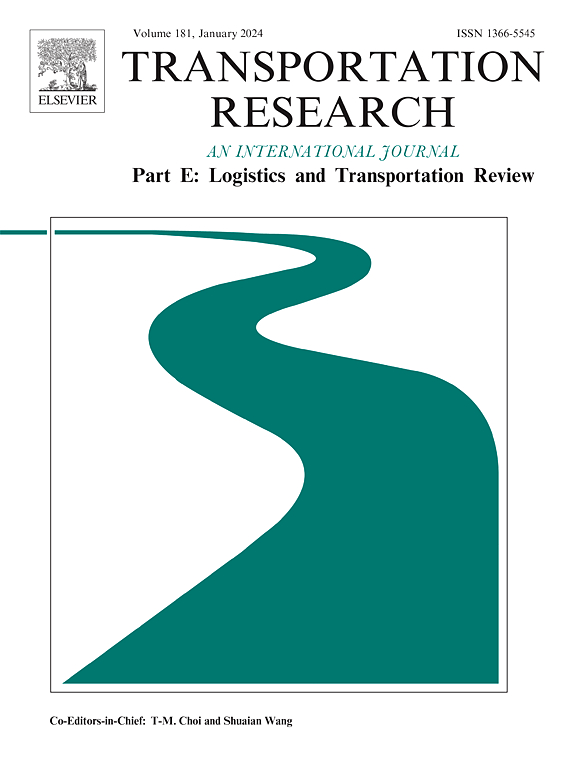Integrated optimization of dynamic deployment and scheduling for rail-mounted gantry cranes in sea-rail intermodal port with on-dock rails
IF 8.8
1区 工程技术
Q1 ECONOMICS
Transportation Research Part E-Logistics and Transportation Review
Pub Date : 2025-07-16
DOI:10.1016/j.tre.2025.104312
引用次数: 0
Abstract
The railway operation area at the sea-rail intermodal port provides the necessary infrastructure for the seamless connection of railway and water transportation, thereby attracting increased railway container flows to the port. Rail-mounted gantry cranes (RMGCs), as the primary handling equipment in this area, play a pivotal role in facilitating swift transshipment of sea-rail intermodal containers. To address the fluctuating workload caused by train arrivals and departures, as well as the time constraints associated with loading and unloading operations, we develop an integrated optimization model for the dynamic deployment and scheduling of RMGCs. This model generates an optimal RMGC profile by effectively allocating crane capacity across both temporal and spatial dimensions. Decision-making regarding dynamic space partitioning, task assignment, and task sequencing is achieved hierarchically through a logic-based Benders decomposition framework, incorporating A* and heuristic strategies for single crane scheduling. Through case analysis, we discuss the performance of various algorithmic variants and the impact of time partitioning on algorithm efficiency. Additionally, we analyze the advantages of employing a flexible number of RMGCs and dynamic task partitioning strategies. Finally, we examine the effects of buffer time settings and train operational characteristics on the RMGC profile. The results indicate that the proposed dynamic deployment and scheduling approach for RMGCs can adapt to variations in workload and different train characteristics, leading to an optimized RMGC profile that minimizes unnecessary equipment mobilization while ensuring timely task completion.
具有码头轨道的海铁联运港口轨道龙门吊动态部署与调度的综合优化
海铁联运港口的铁路作业区为铁路和水运的无缝衔接提供了必要的基础设施,从而吸引了越来越多的铁路集装箱流入港口。轨道式龙门吊作为该地区的主要装卸设备,在实现海铁联运集装箱的快速转运中起着至关重要的作用。为了解决列车进站和出站造成的工作量波动,以及与装卸作业相关的时间限制,我们开发了一个rmgc动态部署和调度的集成优化模型。该模型通过在时间和空间维度上有效地分配起重机能力,生成了最佳的RMGC剖面。通过基于逻辑的Benders分解框架分层实现动态空间划分、任务分配和任务排序的决策,该框架结合了单个起重机调度的a *和启发式策略。通过实例分析,讨论了各种算法变体的性能以及时间划分对算法效率的影响。此外,我们还分析了采用灵活数量的rmgc和动态任务分区策略的优点。最后,我们研究了缓冲时间设置和列车运行特性对RMGC剖面的影响。结果表明,所提出的RMGC动态部署和调度方法可以适应工作量的变化和不同的列车特性,从而优化RMGC配置,最大限度地减少不必要的设备动员,同时确保及时完成任务。
本文章由计算机程序翻译,如有差异,请以英文原文为准。
求助全文
约1分钟内获得全文
求助全文
来源期刊
CiteScore
16.20
自引率
16.00%
发文量
285
审稿时长
62 days
期刊介绍:
Transportation Research Part E: Logistics and Transportation Review is a reputable journal that publishes high-quality articles covering a wide range of topics in the field of logistics and transportation research. The journal welcomes submissions on various subjects, including transport economics, transport infrastructure and investment appraisal, evaluation of public policies related to transportation, empirical and analytical studies of logistics management practices and performance, logistics and operations models, and logistics and supply chain management.
Part E aims to provide informative and well-researched articles that contribute to the understanding and advancement of the field. The content of the journal is complementary to other prestigious journals in transportation research, such as Transportation Research Part A: Policy and Practice, Part B: Methodological, Part C: Emerging Technologies, Part D: Transport and Environment, and Part F: Traffic Psychology and Behaviour. Together, these journals form a comprehensive and cohesive reference for current research in transportation science.

 求助内容:
求助内容: 应助结果提醒方式:
应助结果提醒方式:


